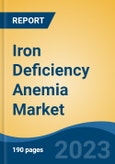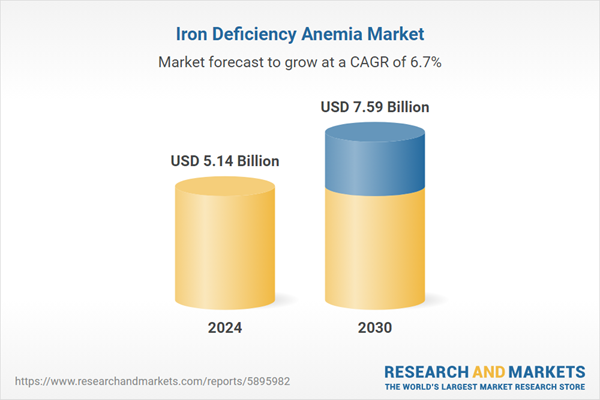Speak directly to the analyst to clarify any post sales queries you may have.
10% Free customizationThis report comes with 10% free customization, enabling you to add data that meets your specific business needs.
This market encompasses a broad spectrum of diagnostic solutions, therapeutic treatments, and supportive care products designed to address the multifaceted nature of IDA. Increased awareness surrounding the condition, along with its potential health consequences, is a major catalyst driving market growth. As global healthcare systems evolve and access to medical services improves, early screening and diagnosis rates are rising - resulting in greater demand for innovative treatment options. In response, pharmaceutical companies and healthcare providers are significantly investing in research and development to advance diagnostic capabilities and therapeutic interventions.
Key Market Drivers
Increasing Global Prevalence of Iron Deficiency Anemia
The escalating prevalence of IDA is one of the most significant growth drivers for the global market. Iron deficiency anemia continues to represent a major global health challenge, impacting individuals across all demographics.Shifts in dietary habits are a key contributor. Modern diets often lack sufficient iron-rich foods, such as red meats and leafy greens, and are increasingly reliant on processed or nutrient-deficient alternatives. The growing adoption of vegetarian and vegan diets, while beneficial for various reasons, may lack heme iron - a form more readily absorbed by the body - further heightening the risk of deficiency. This has fueled demand for iron supplements, fortified foods, and other nutritional solutions.
Additionally, the rising incidence of chronic health conditions has increased vulnerability to IDA. Gastrointestinal disorders such as inflammatory bowel disease and celiac disease can inhibit iron absorption, while chronic inflammation can limit iron availability for red blood cell production. As these underlying health issues become more widespread, the need for effective IDA diagnostics and treatments continues to grow.
Key Market Challenges
Economic Inequality and Limited Access to Healthcare
Despite being a global concern, iron deficiency anemia disproportionately affects individuals in low-income and underserved regions due to economic and healthcare disparities. These disparities present considerable obstacles to diagnosis, treatment, and overall disease management.In many developing countries, access to basic medical services remains limited. Regular health screenings and affordable diagnostic testing are often unavailable, resulting in delayed or missed diagnoses. Even when symptoms are recognized, financial constraints frequently prevent individuals from seeking care or purchasing prescribed treatments.
The affordability and consistent availability of iron supplements - a cornerstone of IDA management - pose an additional challenge. In rural or resource-limited settings, these products may be prohibitively expensive or entirely inaccessible. Vulnerable groups, including pregnant women, infants, and children, are particularly affected, with untreated IDA leading to complications such as preterm birth and developmental delays.
Overcoming these challenges requires targeted policy interventions, expanded healthcare funding, and equitable access to affordable diagnostics and treatments across all population segments.
Key Market Trends
Innovation and Diversification in Treatment Options
Ongoing advancements in IDA treatment have significantly diversified and strengthened the global market. While traditional iron supplements - available in oral, liquid, and intravenous forms - remain central to care, new formulations are improving bioavailability and reducing adverse side effects, thus enhancing patient adherence and outcomes.Innovative treatments such as erythropoiesis-stimulating agents (ESAs) have transformed the management of moderate to severe anemia. These therapies promote red blood cell production, reducing reliance on blood transfusions and offering a more sustainable, patient-friendly option.
Moreover, targeted therapies are emerging to address specific underlying causes of iron deficiency. For example, patients with gastrointestinal disorders that limit iron absorption now have access to specialized treatments designed to optimize iron uptake and utilization. This personalized approach not only improves treatment efficacy but also expands the market by accommodating the diverse clinical needs of the patient population.
Pharmaceutical firms and healthcare organizations continue to invest in research and innovation, enhancing the overall ecosystem for IDA management. This evolution of therapeutic offerings is broadening the market’s reach and solidifying its long-term growth potential.
Key Market Players
- Daiichi Sankyo Company
- Novartis AG
- Rockwell Medical Inc
- Iron4u Aps
- AbbVie Inc
- Sanofi
- Disc Medicine Inc
- Pfizer Inc
- Akebia Therapeutics
- Keros Therapeutics Inc
Report Scope:
In this report, the Global Iron Deficiency Anemia Market has been segmented into the following categories, in addition to the industry trends which have also been detailed below:Iron Deficiency Anemia Market, By Therapy Type:
- Oral Iron Therapy
- Parenteral Iron Therapy
- Red Blood Cell Transfusion
- Others
Iron Deficiency Anemia Market, By Therapy Areas:
- Obstetrics and Gynecology
- Oncology
- Congestive Heart Failure (CHF)
- Inflammatory Bowel Disease
- Renal
- Others
Iron Deficiency Anemia Market, By End User:
- Hospitals & Clinics
- Ambulatory Care Centers
- Others
Iron Deficiency Anemia Market, By Region:
- North America
- United States
- Canada
- Mexico
- Europe
- France
- United Kingdom
- Italy
- Germany
- Spain
- Asia-Pacific
- China
- India
- Japan
- Australia
- South Korea
- South America
- Brazil
- Argentina
- Colombia
- Middle East & Africa
- South Africa
- Saudi Arabia
- UAE
Competitive Landscape
Company Profiles: Detailed analysis of the major companies present in the Global Iron Deficiency Anemia Market.Available Customizations:
With the given market data, the publisher offers customizations according to a company's specific needs. The following customization options are available for the report.Company Information
- Detailed analysis and profiling of additional market players (up to five).
This product will be delivered within 1-3 business days.
Table of Contents
Companies Mentioned
- Daiichi Sankyo Company
- Novartis AG
- Rockwell Medical Inc
- Iron4u Aps
- AbbVie Inc
- Sanofi
- Disc Medicine Inc
- Pfizer Inc
- Akebia Therapeutics
- Keros Therapeutics Inc
Table Information
| Report Attribute | Details |
|---|---|
| No. of Pages | 187 |
| Published | April 2025 |
| Forecast Period | 2024 - 2030 |
| Estimated Market Value ( USD | $ 5.14 Billion |
| Forecasted Market Value ( USD | $ 7.59 Billion |
| Compound Annual Growth Rate | 6.6% |
| Regions Covered | Global |
| No. of Companies Mentioned | 10 |









